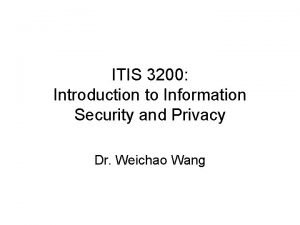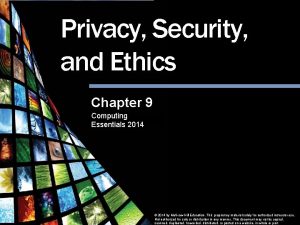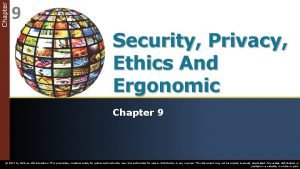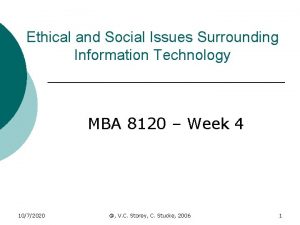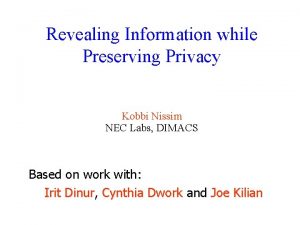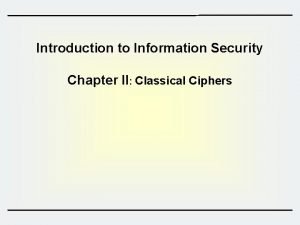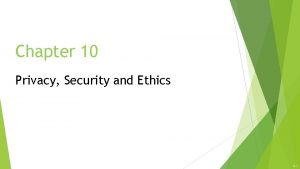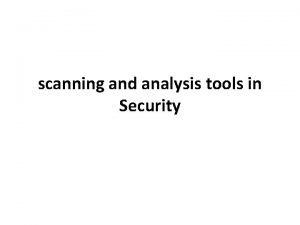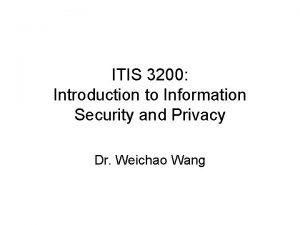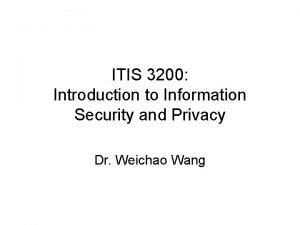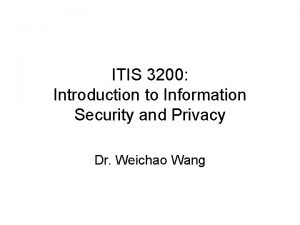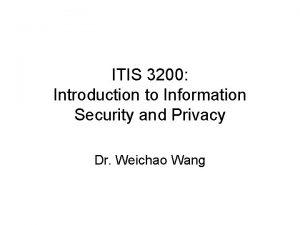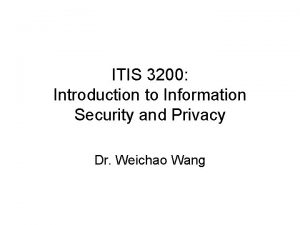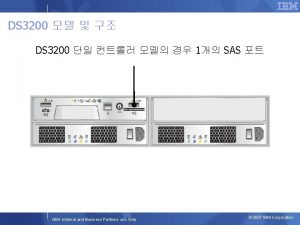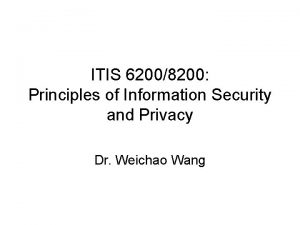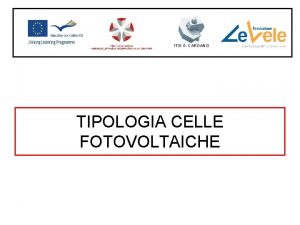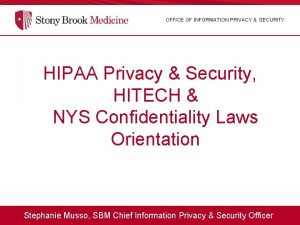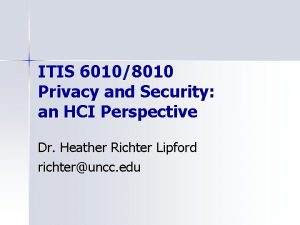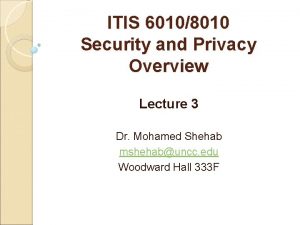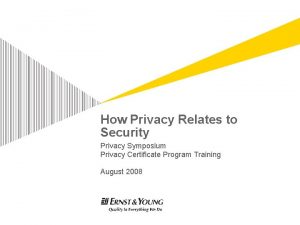ITIS 3200 Introduction to Information Security and Privacy




























- Slides: 28

ITIS 3200: Introduction to Information Security and Privacy Dr. Weichao Wang

Chapter 8: Basic Cryptography • Classical Cryptography • Public Key Cryptography • Cryptographic Checksums 2

Overview • Classical Cryptography (symmetric encryption) – Caesar cipher – Vigenère cipher – DES – AES • Public Key Cryptography (asymmetric encryption) – RSA • Cryptographic Checksums 3

Cryptosystem • Quintuple (E, D, M, K, C) – M set of plaintexts – K set of keys – C set of ciphertexts – E set of encryption functions e: M K C – D set of decryption functions d: C K M – Usually, the cipher text is longer than or has the same length as the plaintext 4

Example • Example: Caesar cipher (a circular shift mapping) – M = { sequences of letters } – K = { i | i is an integer and 0 ≤ i ≤ 25 } – E = { Ek | k K and for all letters m, Ek(m) = (m + k) mod 26 } – D = { Dk | k K and for all letters c, Dk(c) = (26 + c – k) mod 26 } – From the space point of view, C = M 5

Attacks • Opponent whose goal is to break cryptosystem is the adversary – Assume adversary knows algorithm used, but not key – They are after the key and/or data contents • Three types of attacks: – ciphertext only: adversary has only ciphertext; goal is to find plaintext, possibly key – known plaintext: adversary has ciphertext, corresponding plaintext; goal is to find key – chosen plaintext: adversary may supply plaintexts and obtain corresponding ciphertext; goal is to find key – It is not difficult to know both ciphertext and plaintext 6

Basis for Attacks • Mathematical attacks – Based on analysis of underlying mathematics – For example: the safety of RSA is based on the difficulty to factor the product of two large prime numbers. If it is broken, then RSA will become unsafe. • Statistical attacks – Make assumptions about the distribution of letters, pairs of letters (digrams), triplets of letters (trigrams), etc. • Called models of the language – Examine ciphertext, correlate properties with the assumptions. 7

Classical Cryptography (symmetric) • Sender, receiver share common key – Keys may be the same, or trivial to derive one from the other – Sometimes called symmetric cryptography – How to distribute keys: following chapters • Two basic types – Transposition ciphers (shuffle the order) – Substitution ciphers (replacement) – Combinations are called product ciphers 8

Transposition Cipher • Rearrange letters in plaintext to produce ciphertext • Example (Rail-Fence Cipher) – Plaintext is HELLO WORLD – Rearrange as HLOOL ELWRD – Ciphertext is HLOOL ELWRD (order the letters in vertical, send out in horizontal) 9

Attacking the Cipher • Anagramming – The frequency of the characters will not change – The key is a permutation function – If 1 -gram frequencies match English frequencies, but other n-gram frequencies do not, probably transposition – Rearrange letters to form n-grams with highest frequencies 10

Example • Ciphertext: HLOOLELWRD • Frequencies of 2 -grams beginning with H – HE 0. 0305 – HO 0. 0043 – HL, HW, HR, HD < 0. 0010 • Frequencies of 2 -grams ending in H – WH 0. 0026 – EH, LH, OH, RH, DH ≤ 0. 0002 • Implies E follows H 11

Example • Arrange so the H and E are adjacent HE LL OW OR LD • Read off across, then down, to get original plaintext • May need to try different combinations or ngrams 12

Substitution Ciphers • Change characters in plaintext to produce ciphertext – The replacement rule can be fixed or keep changing • Example (Caesar cipher) – Plaintext is HELLO WORLD – Change each letter to the third letter after it in the alphabet (A goes to D, ---, X goes to A, Y to B, Z to C) • Key is 3, usually written as letter ‘D’ (which letter to replace “A”) – Ciphertext is KHOOR ZRUOG 13

Attacking the Cipher • Exhaustive search – If the key space is small enough, try all possible keys until you find the right one – Caesar cipher has 26 possible keys – On average, you only need to try half of them • Statistical analysis – The ciphertext has a character frequency – Compare (and try to align it) to 1 -gram model of English 14

Statistical Attack • Compute frequency of each letter in ciphertext: G 0. 1 R 0. 2 H 0. 1 U 0. 1 K 0. 1 Z 0. 1 O 0. 3 • Apply 1 -gram model of English – Frequency of characters (1 -grams) in English is on next slide 15

Character Frequencies a 0. 080 h 0. 060 n 0. 070 t 0. 090 b 0. 015 i 0. 065 o 0. 080 u 0. 030 c 0. 030 j 0. 005 p 0. 020 v 0. 010 d 0. 040 k 0. 005 q 0. 002 w 0. 015 e 0. 130 l 0. 035 r 0. 065 x 0. 005 f 0. 020 m 0. 030 s 0. 060 y 0. 020 g 0. 015 z 0. 002 16

Frequency chart of English Frequency chart of ciphertext 17

Statistical Analysis • Try to align the two charts • f(c): frequency of character c in ciphertext • (i): correlation of frequency of letters in ciphertext with corresponding letters in English, assuming key is i – (i) = 0 ≤ c ≤ 25 f(c)p(c – i) – (i) = 0. 1 p(6 – i) + 0. 1 p(7 – i) + 0. 1 p(10 – i) + 0. 3 p(14 – i) + 0. 2 p(17 – i) + 0. 1 p(20 – i) + 0. 1 p(25 – i) • p(x) is frequency of character x in English – This correlation value should be a maximum when the two charts are aligned 18

Correlation: (i) for 0 ≤ i ≤ 25 i 0 1 2 3 4 5 6 (i) 0. 0482 0. 0364 0. 0410 0. 0575 0. 0252 0. 0190 0. 0660 i 7 8 9 10 11 12 (i) 0. 0442 0. 0202 0. 0267 0. 0635 0. 0262 0. 0325 i 13 14 15 16 17 18 (i) 0. 0520 0. 0535 0. 0226 0. 0322 0. 0392 0. 0299 i 19 20 21 22 23 24 25 (i) 0. 0315 0. 0302 0. 0517 0. 0380 0. 0370 0. 0316 0. 0430 19

The Result • Most probable keys, based on : – i = 6, (i) = 0. 0660 • plaintext EBIIL TLOLA – i = 10, (i) = 0. 0635 • plaintext AXEEH PHKEW – i = 3, (i) = 0. 0575 • plaintext HELLO WORLD – i = 14, (i) = 0. 0535 • plaintext WTAAD LDGAS • Only English phrase is for i = 3 – That’s the key (3 or ‘D’) • The algorithm will become more complicated if the encryption is not a circular shift • We are only reducing the searching space by guided guess 20

Caesar’s Problem • Key is too short – Can be found by exhaustive search – Statistical frequencies not concealed well • They look too much like regular English letters – The most frequently seen character could be “E” • So make it longer – Multiple letters in key – Idea is to smooth the statistical frequencies to make cryptanalysis harder • What if in the cipher text, every character has the same frequency? • All correlation will have the same value 21

• What we can get from this: – If the key contains only 1 character, we have 26 choices – If the key contains m characters, we need to try 26 ^ m combinations. m=5, 12 million choices. 22

Vigenère Cipher • Like Caesar cipher, but use a longer key • Example – Message THE BOY HAS THE BALL – Key VIG (right shift 21, 8, 6 times, then repeat) – Encipher using Caesar cipher for each letter: key VIG VIG VIG V plain THE BOY HAS THE BAL L cipher OPK WWE CIY OPK 23 WIR G

• Now we have: – Three groups of characters encrypted by V, I, and G respectively – Each group is a Caesar cipher (fixed shift offset) – Approach: • Figure out the length of the key • Decipher each group as a Caesar’s cipher – Hint: when the same plaintext is encrypted by the same segment of key, we have the same cipher • Can be used to derive the period 24

Attacking the Cipher • Approach – Establish period; call it n – Break message into n parts, each part being enciphered using the same key letter • So each part is like a Caesar cipher – Solve each part • You can leverage one part from another because English has its special rule 25

Establish Period • Kasiski: repetitions in the ciphertext occur when characters of the key appear over the same characters in the plaintext • Example: key VIG VIG VIG V plain THE BOY HAS THE BAL L cipher OPK WWE CIY OPK WIR G Note the key and plaintext line up over the repetitions (underlined). As distance between repetitions is 9, the period is a factor of 9 (that is, 1, 3, or 9) 26

• We guess the period is 3, so we divide the cipher text into three groups – Each group is a Caesar cipher – Using previous approaches to solve them 27

One-Time Pad • A Vigenère cipher with a random key at least as long as the message – Provably unbreakable – Why? Every character in the key is random. It has the same chance to be “a”, “b”, ---, “z” – Look at ciphertext DXQR. Equally likely to correspond to plaintext DOIT (key AJIY) and to plaintext DONT (key AJDY) and any other 4 -letter words – Warning: keys must be random, or you can attack the cipher by trying to regenerate the key 28
 Itis 3200
Itis 3200 Privacy awareness and hipaa privacy training cvs answers
Privacy awareness and hipaa privacy training cvs answers Azure security privacy compliance and trust
Azure security privacy compliance and trust Chapter 9 privacy security and ethics
Chapter 9 privacy security and ethics Chapter 9 privacy security and ethics
Chapter 9 privacy security and ethics Chapter 9 privacy security and ethics
Chapter 9 privacy security and ethics Hipaa privacy and security awareness training
Hipaa privacy and security awareness training Cyberextortionist definition
Cyberextortionist definition Provate security
Provate security Visa international security model diagram
Visa international security model diagram Information security
Information security Berat bayi yang baru lahir rata rata 3200 gram
Berat bayi yang baru lahir rata rata 3200 gram Gvc 3200
Gvc 3200 Ds 3200
Ds 3200 Fuji 3200
Fuji 3200 Sempron 3200+
Sempron 3200+ Michigan cps 3200
Michigan cps 3200 Acc 3200
Acc 3200 Social issues in information technology
Social issues in information technology Revealing information while preserving privacy
Revealing information while preserving privacy Roman emperors cipher
Roman emperors cipher Wireless security in cryptography and network security
Wireless security in cryptography and network security E commerce security policy
E commerce security policy Dignity champion certificate
Dignity champion certificate Ferpa law
Ferpa law Family educational rights and privacy act of 1974
Family educational rights and privacy act of 1974 Confidentiality and privacy controls
Confidentiality and privacy controls Three primary privacy issues are accuracy property and
Three primary privacy issues are accuracy property and Scanning and analysis tools are used to pinpoint
Scanning and analysis tools are used to pinpoint
